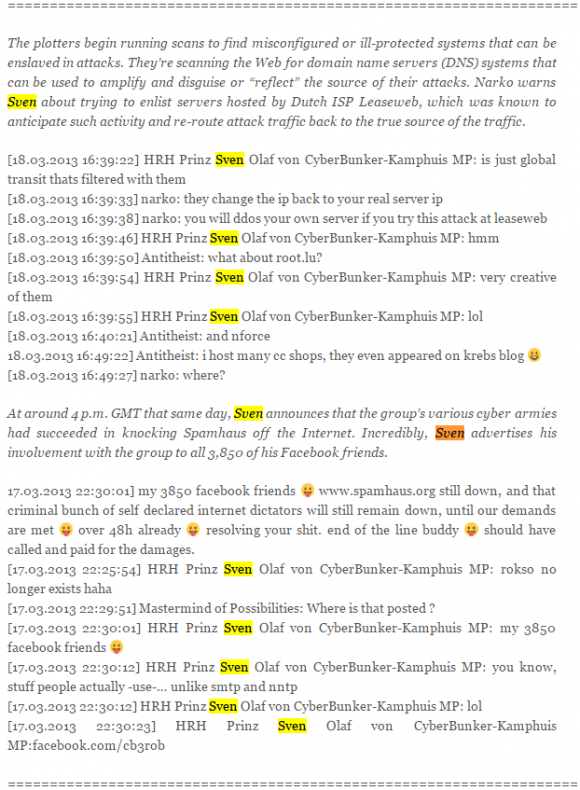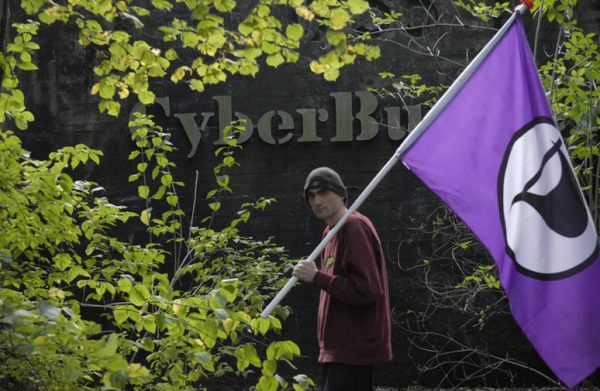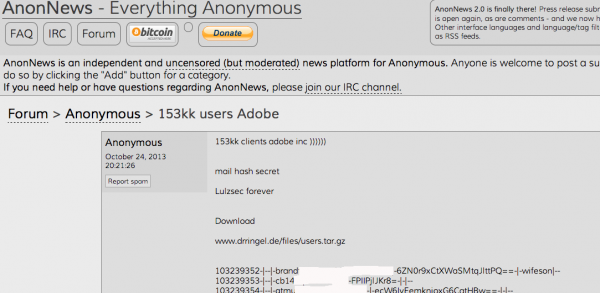Adobe will pay just $1 million to settle a lawsuit filed by 15 state attorneys general over its huge 2013 data breach that exposed payment records on approximately 38 million people. In other news, the 39-year-old Dutchman responsible for coordinating an epic, weeks-long distributed denial-of-service attack against anti-spam provider Spamhaus in 2013 will avoid any jail time for his crimes thanks to a court ruling in Amsterdam this week.
On Oct. 3, 2013, KrebsOnSecurity broke the story that Adobe had just suffered a breach in which hackers siphoned usernames, passwords and payment card data on 38 million customers. The intruders also made off with digital truckloads of source code for some of Adobe’s most valuable software properties — including Adobe Acrobat and Reader, Photoshop and ColdFusion.
On Monday, Nov. 11, North Carolina Attorney General Roy Cooper joined his counterparts in 14 other states in announcing a $1 million settlement with Adobe over the 2013 breach. According to Cooper, the hacked Adobe servers contained the personal information of approximately 552,000 residents of the participating 15 states. That works out to about $1.80 per victim across all 15 states.
According to a statement by Massachusetts Attorney General Maura Healey, “an investigation by the states revealed that in September 2013, Adobe received an alert that the hard drive for one of its application servers was nearing capacity. In responding to the alert, Adobe learned that an unauthorized attempt was being made to decrypt customer payment card numbers maintained on the server.”
“Adobe discovered that one or more unauthorized intruder(s) had compromised a public-facing web server and used it to access other servers on Adobe’s network, including areas where Adobe stored consumer data,” the statement from Healey’s office reads. “The intruder(s) ultimately stole consumer data from Adobe’s servers, including encrypted payment card numbers and expiration dates, names, addresses, telephone numbers, e-mail addresses, usernames (Adobe IDs), and passwords associated with the usernames.”
When I think of the Adobe breach I’m reminded of that scene out of the 1982 Spielberg horror classic “Poltergeist,” when Craig T. Nelson as “Steve Freeling” seizes the horrified neighborhood developer Mr. Teague by his coat collars and screams, “You son of a bitch! You moved the cemetery but you left the bodies, didn’t ya?! You left left the bodies and you only moved the headstones!! Why?!?!?! Whyyyyyyeeeiee??!?!?”

A scene from Poltergeist. Image: IMDB.
Likewise, Adobe had various storefronts for its various software products, but it eventually centralized many store operations. The main trouble was the company left copies of their customer records in multiple internal network locations that were no longer as protected as Adobe’s globally centralized storefront.
North Carolina’s Cooper said in a statement on the settlement that businesses and government must do more to protect consumer data. But if this settlement was meant as a deterrent to dissuade other companies from hosting customer payment data on public-facing Web servers, the fine might be more effective if it were more commensurate with the company’s size and the number of customers impacted.
As Digital Trends notes, such a breach under the new General Data Protection Regulation going into effect in 2018, would be quite a bit more costly. “Adobe could face fines of up to four percent of its annual global turnover,” wrote Jonathan Keane for DT. “Last we checked, Adobe’s previous quarterly earnings were $1.4 billion.”
Keane also notes that Adobe had previously settled a similar case in California where it settled for an undisclosed amount and $1.1 million in legal fees.
One interesting nugget tucked in at the end of the statement from the North Carolina AG’s office is this bit: More than 3,700 breaches impacting nearly 10 million North Carolinians have been reported since the state’s data breach notification law took effect in 2005, including 677 breaches reported so far in 2016. According to the United States Census Bureau, there were just over 10 million residents in North Carolina as of July 2015.
That means just about everyone in North Carolina was impacted by at least one data breach over the past 12 years. I’d wager this is true for just about every state in the Union, and probably many times over for some. A handful of lucky states have had single breaches that affected all citizens at once.
In 2012, a phishing attack against an employee of the South Carolina Department of Revenue allowed intruders to make off with Social Security numbers and other personal data on 3.8 million electronic tax filers, as well as 1.9 million of their dependents. Also in that breach, nearly 700,000 businesses, 3.3 million bank accounts and 5,000 expired credit cards were compromised. As of July 2015, South Carolina had fewer than five million residents, according to the Census Bureau.
SVEN OLAF KAMPHUIS — A.K.A. “Prince of Cyberbunker Republic”
In March 2013, a coalition of spammers and spam-friendly hosting firms pooled their resources to launch what would become the largest distributed denial-of-service (DDoS) attack the Internet had ever witnessed. The assault briefly knocked offline the world’s largest anti-spam organization, and caused a great deal of collateral damage to innocent bystanders in the process. Here’s a never-before-seen look at how that attack unfolded, and a rare glimpse into the shadowy cybercrime forces that orchestrated it.
That paragraph above was the lead for a story I published in August 2016, “Inside the Attack that Almost Broke the Internet“. It’s starring member was a colorful Dutchman named Sven Olaf Kamphuis who ran a technology services company called CB3ROB. This CB3ROB in turn provided services for a Dutch company called “Cyberbunker,” so named because the organization was allegedly housed in a five-story NATO bunker and because it had advertised its services as a bulletproof hosting provider.

A snippet from a very long chat log published here detailing the extended DDoS campaigns waged against Spamhaus.
Kamphuis seemed to honestly believe his Cyberbunker was sovereign territory, even signing his emails “Prince of Cyberbunker Republic.” Arrested in Spain in April 2013 in connection with the attack on Spamhaus, Kamphuis was later extradited to The Netherlands to stand trial. He has publicly denied being part of the attacks, but the chat logs with him coordinating the attack with co-conspirators are fairly damning considering he didn’t even use an alias in the discussions and live-posted his campaign of terror to his Facebook account.
Nevertheless, a judge in Amsterdam this week sentenced Kamphuis to a total of 240 days in jail. However, the judge also counted the 55 days Kamphuis spent awaiting extradition from Spain, and suspended the remaining 185-day sentence. No jail time for Kamphuis.
Spamhaus founder Steve Linford said the organization was disappointed in the sentence, and it warned Kamphuis about any thoughts of retaliation.
“We had hoped for a longer jail sentence to send the message that organising and conducting DDoS attacks is a crime not acceptable to law courts or society, however the ease with which Kamphuis was arrested and extradited, and the two months already served in jail will hopefully have delivered the message to him that there is no escape from the law should he attempt any attacks in the future,” Linford wrote in a email. “Since the remainder of the term is a suspended sentence, any actions or threats made to Spamhaus during the term would be filed with the court as a violation of the conditions of the suspended sentence.”

Facebook profile picture of Sven Olaf Kamphuis
The only other person charged in connection with the largest attack the Internet had ever seen at the time was Sean Nolan McDonough, a.k.a. “narko” in the chat logs referenced in the snippet pictured above.
Narko was a juvenile when he was arrested by the U.K.’s National Crime Agency (NCA); when the NCA raided Narko’s home, they found his computer still logged in to crime forums, and they seized £70,000 from his bank account (believed to be payments for DDoS attacks). Narko later pleaded guilty to coordinating the attacks and was sentenced to 240 hours of community service, but because of his age and in return for cooperating with the NCA he avoided a jail term.
This sentence sends the wrong message and misses the mark by a mile. The message we as a society of Internet users continue to send by our unwillingness to punish people for these crimes is, “Hey, if you’re involved in heavily disrupting networks and commerce through botnet attacks, you don’t have to worry because you’ll either never be prosecuted…or if you are the sentence will be community service or nothing.”
Neither of the two 18-year-old Israeli men arrested in September for their role in selling the massively profitable vDOS attack-for-hire service to knock Web sites offline have been indicted by the Israeli, British or American governments. The hammer has yet to fall on those responsible for lobbing the record 620 Gpbs attack on my site, or the individual(s) involved in the attack on Dyn that disrupted service for some of the Web’s top destinations. I’m afraid the wheels of justice still creak forward far too slowly in Internet time for the threat of prosecution to be much of an immediate deterrent against online hooliganism in the here-and-now.





Yet another example of the failure to provide real protection to consumers by the feckless A-Gs which have inhabited that position in Texas (who chose to stay out of this suit) for the past few decades.
The primary virtue of the Stoics….
JUSTICE!
We all need to find a genie for Mr. Krebs; he has such noble wishes.
“Poltergeists are usually associated with an individual. Haunting seem to be connected with an area. A cyber-bunker usually. “
Lawsuits against corporations are a certain proof: (1) we have too many lawyers, and (2) our economy is in meltdown. Hacker attacks fall under the category of “unforeseeable” acts. ADOBE is guilty of nothing, nothing whatsoever.
Nothing? Really? LMFAO
Stick the world with faulty, vulnerable, crapware that people can be easily convinced they need. How many lives have been hurt financially if not ruined because of this? How many ID theft cases could have been prevented or stopped but for their software? How many security breaches would not have happened but for them? Sure, other means would have been looked for but this is the back door from which a thousand ships were launched.
It’s time for someone to deal with the problem instead of throwing band-aids on things.
“Lawsuits against corporations frequently prove that the corporations have polluted the streams of commerce with noxious substances and/or services, and remedies are found in part through courts of law.” There, fixed it for you, now develop your naive libertarianism in the light of centuries of wisdom stretching back to Republican Rome and even further.
You’re welcome.
Actually, our economy is stronger than it’s been in years. GDP is up. Consumer confidence is up. Unemployment is down.
Adobe is 100% liable – they didn’t adequately secure their servers and isolate their networks to prevent the breach. That’s called negligence.
Some of the cause of problem falls on the consumer however, for allowing themselves to be suckered by “convenience”. The corporate entities that have to worry here legally, I believe, are those that force you to store payment information on their databases to participate in commerce. Corporations such as e.g. Amazon.
I say that because the easiest way to protect oneself from these data breaches is to not have the data on or accessible from the web in the first place. An individual not wanting to input that credit card number again by having corporation X store the information on their databases waives security for convenience, IMHO. The same with electronic tax return filers. Breaches usually tend to occur mostly because of some failure of the wetware, not necessarily due to some systemic failure…
As to Sven, an old WWII adage comes to mind: “Loose lips sink ships”
The storage of PII and credit card data is solved by Apple Pay. Press your friendly online retailer to up their game by dumping stored info and adding an Apple Pay button.
The storage of PII does not go away just because you use Apple Pay. This idea is pure fantasy and is part of why so many people have such a warped way of thinking when it comes to security related issues. Kinda like how so many people think WiFi is a better ‘modern’ way of doing things (it isn’t). People are shooting themselves in the foot by going all wifi.
Grocery stores with their customer loyalty cards, auto parts stores, department stores, utilities, ISP’s, medical facilities, law offices, federal buildings, and various other places are going to keep records on you. This is such a big part of the problem. These is the data bases that are being breached. Do you really think that Apple Pay would have prevented Ashley Madison from getting hacked? Adult Friend Finder? Target?
The reason is quite simple Brian: Whoever fights against spam, hurts the advertising lobby and the bandwidth sellers of the big telcos.
This shows, that it’s not illegal. If anything, it’s part of normal everyday operations to forget the consumer, and that the attack on the web, was legal. Wonder which security agency hired them afterwards.
One million dollar fine, huh? Very punitive. That’s gonna make it a little bit tougher for Larry Ellison to develop Lanai, isn’t it?
Um, I think you are confusing Adobe with Ellison’s Oracle.
They are not the same, nor related.
https://en.m.wikipedia.org/wiki/List_of_acquisitions_by_Oracle
My bad! Don’t know where I formed that wrong impression.
Now I do! Since Adobe and Java are so intertwined, I conflated the two enterprises. My bad again.
Adobe exposes details on 38M users, and cops a file of $1m. That works out at 2.6 cents per exposure. I wonder if each victim is satisfied that their exposure was only worth a 2.6 cent penalty.
Or to look at the mathematics another way, a company with $5.5 billion in annual revenue is fined $1 million. This ratio is about the same as someone making $50K a year being fined $20. Less than a parking ticket in most cities.
5.5 Billion – 3.5 Billion (for paying all those thousands of employees, their benefits, and their training) – 750 Million (for just paying the bills for that year) – 500 million to 1 Billion (for various taxes, federal compliance fees, and whatever legal fines that might come up during that year)
Then divide whatever is left between all the top level owners.
We need to form a special international hit squad to take out these scums of the earth. Project Black Briar? By the way why can’t we turn off UDP across the internet already? Move DNS, NTP off of it and make them work with TCP.
Adobe’s fined $1M? Something they’ll find in the change in the couch? This is going to get them to be serious about security? Maybe $100M they might have noticed. $1B *might* have actually gotten their attention.
A coordinated strategy between carriers and ISP is required at a global level to tackle this rapidly growing problem as the current DDoS defensive capabilities are becoming less effective.